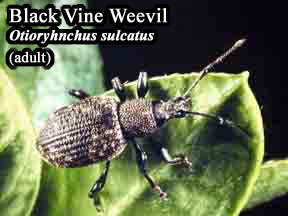Boston Ivy (Parthenocissus)
Plant Health Problems
Diseases caused by Fungi:
Leaf spots, Guignardia, Cercospora.
Irregular or circular, pale tan spots with dark brown borders develop on
leaves and are characteristic of infection by these fungi. Leaves may also turn
yellow and drop prematurely.
Efforts to maximize plant vigor by fertilizing and watering are helpful. However,
watering should be done early in the day to give the foliage a chance to dry
before nighttime. It is also helpful to pick and remove symptomatic leaves as
soon as they develop. Although not usually necessary, applications of
fungicides can be made when new growth emerges in the spring. Among the
compounds registered for use in Connecticut are ferbam, mancozeb, and copper
compounds. Consult the label for dosage rates and safety precautions.
Powdery mildew, Uncinula.
White powdery spots or patches develop on leaves and occasionally on stems.
Symptoms often first appear on the upper surfaces of the leaves and are usually
most pronounced during hot weather. Heavily infected leaves turn brown and
shrivel.
Disease can be minimized by avoiding overcrowded spacing of plants and by
carefully picking off affected leaves as soon as symptoms are evident.
Symptomatic leaves can be placed into a plastic bag in order to avoid spreading
the spores of the fungus to other plants. Use of fungicides is usually not necessary.
However, applications can be made as soon as symptoms are visible. Among the
compounds registered for use in Connecticut are horticultural oil, sulfur,
potassium bicarbonate, and thiophanate-methyl. Consult the label for dosage
rates and safety precautions.
Insect Problems:
 Black vine weevil, Otiorhynchus sulcatus.
Black vine weevil, Otiorhynchus sulcatus.
This weevil can feed on leaves and roots of Boston ivy. The larvae of this
weevil often injure plants in nurseries and ornamental plantings by feeding on
the roots. The grubs devour the small roots and gnaw the bark from the larger
roots, often girdling them. The tops of girdled plants first turn yellow, then
brown, and the severely injured plants die. Large landscape plants tolerate
root grazing quite well, but leaf notching by adults can be unsightly. The
1/2" long adult weevil is black, with a beaded appearance to the thorax
and scattered spots of yellow hairs on the wing covers. Only females are known,
and the adults are flightless. They feed nocturnally, notching the margins of
the foliage. The legless grub is white with a brown head and is curved like
grubs of other weevils. Adults and large larvae overwinter, emerging from May -
July. The adults have to feed for 3-4 weeks before being able to lay eggs.
Acephate and fluvalinate are among the compounds registered for control of this
pest in Connecticut, and should be applied when adults are feeding and before
they start laying eggs. The usual timing for these foliar sprays is during May,
June and July at three week intervals. Insecticide resistance is very common;
be aware that adults may appear to be dead following contact with fluvalinate,
but may recover from poisoning within a few days. Consult the label for dosage
rates and safety precautions. Treating the soil with insect pathogenic
nematodes may control the larvae.
Eightspotted forester, Alypia octomaculata.
Caterpillars are cross-banded with black, white, and orange and feed upon the
foliage of Virginia creeper and Boston ivy, sometimes stripping the vines. The
adult is a black moth with a wingspread of 1 1/4 to 1 1/2", with two pale
yellow spots on each forewing and two white spots on each rear wing. The insect
winters as a pupa in the soil, and there is only one generation each year in
Connecticut. Handpicking is the only control needed, except occasionally when
the insect is very abundant, in which case a spray of Bacillus thuringiensis
var. aizawai will prove effective. This material is registered for
control of this pest in Connecticut; consult the label for dosage rates and safety
precautions.
Leafhoppers.
Leafhoppers that usually infest grapes are also found on Boston ivy. When the
population is damaging, spray the undersurface of the leaves with carbaryl,
which is among the compounds registered for control of this pest in
Connecticut. Imidacloprid applied as a systemic to be taken up by the roots
will also provide season-long control. Consult the label for dosage rates and
safety precautions.
Soft scale, Coccus hesperidum.
This soft scale is very thin, oval, and semi-transparent. It infests many
different greenhouse plants including Boston ivy. Any control sprays may need
to be repeated if only the crawler stage is controlled. Imidacloprid applied as
a systemic to be taken up by the roots will also provide season-long control.
Consult the label for dosage rates and safety precautions.
Sphinx caterpillars, Sphecodina abbotii, Ampelophaga myron.
Some of the sphinx caterpillars or hornworms that are found on grape
occasionally occur on Boston ivy. There are several kinds of hornworms or
sphinx caterpillars that often feed on grape leaves. Some of these are the
abbot sphinx, Sphecodina abbotii, the hog caterpillar, Ampelophaga
myron, and two less common species, the achemon sphinx, Pholus archemon,
and the Pandorus sphinx, Pholus pandorus. Hand picking is the remedy in
common practice, but where the vines are sprayed with methoxychlor, which is
among the compounds registered for control of this pest in Connecticut, these
caterpillars have been killed. Consult the label for dosage rates and safety
precautions.

